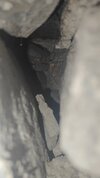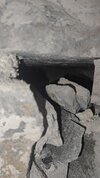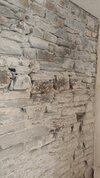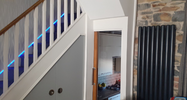- Joined
- 25 Jun 2024
- Messages
- 4
- Reaction score
- 2
- Country

Hi All,
I've done a bunch of Googling but can't find any specific answers to my problem/question.
I'm repointing some stone walls. It's all going well but having removed old pointing in some areas I'm discovering large cavities within the stone wall. Where possible I'm fitting correct sized stone to fill the holes and pointing around the stone.
In some cases though, there can be a small hole in the wall leading to a larger cavity inside the wall. I would think plugging those holes simply seals an air pocket in the wall.
I'm thinking I have 5 options:
1.) fill large cavities with cement - bad idea since cement won't let moisture out.
2.) fill large cavities sand - run the risk of the sand flowing through a hole and out lower in the wall.
3.) fill large cavities with gravel.
4.) fill large cavities with left over lime mortar rubble.
5.) cover the hole and leave the cavities unfilled.
I moved here from Western North America so that makes me a little paranoid about houses shifting and earthquakes. My thinking is if I fill cavities somehow then if the stones do ever shift it's a movement of 1-2mm rather than the entire in hole if left unfilled.
It seems logical to me to fill with either gravel or old lime mortar rubble. The larger pieces are more likely to seal small hikes and less likely to flow out as sand might.
Is this the best approach? Or is it a bad idea? Any downside or upside to doing it this way? Or any better options I haven't thought of?
Thanks!
SL
I've done a bunch of Googling but can't find any specific answers to my problem/question.
I'm repointing some stone walls. It's all going well but having removed old pointing in some areas I'm discovering large cavities within the stone wall. Where possible I'm fitting correct sized stone to fill the holes and pointing around the stone.
In some cases though, there can be a small hole in the wall leading to a larger cavity inside the wall. I would think plugging those holes simply seals an air pocket in the wall.
I'm thinking I have 5 options:
1.) fill large cavities with cement - bad idea since cement won't let moisture out.
2.) fill large cavities sand - run the risk of the sand flowing through a hole and out lower in the wall.
3.) fill large cavities with gravel.
4.) fill large cavities with left over lime mortar rubble.
5.) cover the hole and leave the cavities unfilled.
I moved here from Western North America so that makes me a little paranoid about houses shifting and earthquakes. My thinking is if I fill cavities somehow then if the stones do ever shift it's a movement of 1-2mm rather than the entire in hole if left unfilled.
It seems logical to me to fill with either gravel or old lime mortar rubble. The larger pieces are more likely to seal small hikes and less likely to flow out as sand might.
Is this the best approach? Or is it a bad idea? Any downside or upside to doing it this way? Or any better options I haven't thought of?
Thanks!
SL
Last edited:




